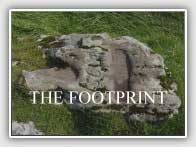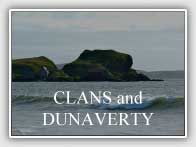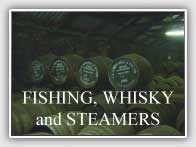BOATS, FORTS
AND VIKINGS
These days, roads are the fastest type of transport from one place to another. But it wasn't always so. From earliest times and other than struggling through trackless acres of scrub with what you could carry on your back, some sort of sea transport was much easier.
Stone age (from 7,000 BC onwards) flint flakes and tools have been found wherever there was settlement in Kintyre. But flint does not occur naturally here. It had to be imported across the water from Ireland - by who knows what form of boat in the beginning!
Later developments, the curach, the longship and the galley meant that controlling the seas, controlled the entire area. Which was great for those in power, but not so good for those trying to make a living for themselves on the land.
Two forms of protection developed, the Dun (pronounced doon) and the Fort. The Dun was essentially a fortified dwelling for a single family group. Good examples of this are Kildonan Dun, signposted beside the road north of Peninver, and Borgadale Dun, only accessible by a hike across the moorland of the Mull.
Forts were much larger enclosures for organised groups of families. Mostly mere grassy mounds where the walls used to be (our children have grown up thinking that 'Fort' means grassy mound!), but there is a stunning example at Sron Uamha, if you can cope with the rugged hike to get there.
Nevertheless, despite these fortifications, Viking raiders still held the upper hand. Sea power was so important that these lands were ceded to whomever could control them. In 1098, Magnus Barelegs, the King of Norway, was granted control by King Malcolm III, King of the Scots, of all the lands which he could sail around. So he claimed all of the Islands and he also claimed Kintyre… by having his ship, with himself at the helm, pulled across the narrow neck of land that is all that joins Kintyre to the mainland at Tarbert (Tarbert actually means "boat pull").
In 1156 the great celtic warrior and King of Kintyre, Somerled, used his galleys to take advantage of the vacuum left by the deaths of the Kings of the Scots and of Mann. With 80 ships from his fleet of galleys, he defeated the powerful Jarl, Thorfin of the Hebrides and united all of the islands south of Ardnamurchan into the Viking/Celtic Lordship of the Isles.
Somerled died in battle in 1194, trying to invade mainland Scotland, but his sons went on to found many of the major clans of Scotland, including the MacDonalds, the MacDougalls and the MacLeods.
Please note, these are merely snippets of history and are not to be taken as either authoritative or by any means comprehensive!






